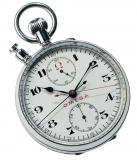Folders |
OMEGA Timekeeping Technology at the 2013 Prefontaine ClassicPublished by
For the fourth straight year, OMEGA serves as the Official Timekeeper of the IAAF Samsung Diamond League and Prefontaine Classic. OMEGA Timing has deployed specially-trained timekeepers from Switzerland armed with a venerable arsenal of advanced sports timekeeping, measurement and data handling equipment to time the fastest men and women in the world as they compete in Eugene, Ore.
OMEGA has a rich history in athletics – a sport in which first and second place is only separated by split seconds at the finish line. In addition to its timekeeping and data handling responsibilities at some of the world’s highest-profile sporting events, including the Olympic Games, serving as Official Timekeeper at 24 Games since 1932, OMEGA has been responsible for the development of key technologies in sports timing, including the cutting-edge timekeeping technologies for Track & Field.
The innovative OMEGA timekeeping technology being used at Hayward Field includes OMEGA starting blocks, OMEGA false-start detection systems and the latest OMEGA photo-finish cameras for the sprints and middle-distance events, as well as height and distance measurement devices for field disciplines.
Starting Blocks and Reaction Times In modern athletic timekeeping, the starting blocks feature built-in sensors which are a key component in OMEGA’s advanced false-start detection technology. Each set of starting blocks is outfitted with a loudspeaker linked to the electronic flash gun so that all contestants hear the start signal at precisely the same time.
At the start of each race, the sensors in the false-start detection system measure each runner’s reaction time, defined as the interval between the sound of the starter’s pistol and the athlete’s response. Each runner’s response to the sound of the electronic start gun (pressure exerted by the athlete’s foot against the blocks) is detected by the sensors built into the starting blocks and measured by the OMEGA timing device. If the time measured is less than the time in which a person can possibly react to the sound of the starter’s gun, the runner has “jumped the gun” and the timekeeper signals a false start.
The rules of the IAAF (International Association of Athletics Federations) fix the minimum time of physiological reaction at 100 milliseconds (a tenth of a second). Any reaction which takes place below this limit is considered to be premature and places the runner in a false start situation.
The Electronic Start System – Replacing an Iconic Symbol One of the most enduring images from any major athletics event is the starting pistol, reminiscent of the revolvers so popular in movies set in the Old West. At the Vancouver 2010 Olympic Winter Games, this was replaced by a streamlined, futuristic device composed of a flash gun and a sound generation box.
When the starter presses its trigger, three things happen simultaneously: a sound is “played,” a light flash is emitted, and a start pulse is given to the timing device. By pressing the trigger a second time within two seconds, the false start will be audibly signaled. The sounds can be changed and downloaded by computer. As was the case with traditional powder pistols, the sound is reproduced by speakers near each competitor, guaranteeing that they will hear the signal at the same time. At some venues, the audio signals can also be put on the public address system.
The Photofinish Camera Perhaps the most widely known sports timekeeping device used in athletics is the OMEGA Scan‘O’Vision, the photo-finish camera set up at the finish line of sprints, hurdles and other races. Although a film camera was used to record the end of some of the events at the 1912 Stockholm Olympic Games, it wasn’t until 1948 in London that the photofinish camera as we know it today was used at a major athletics event. The camera, developed and operated by Race Finish Recording Company, was used in conjunction with OMEGA’s photoelectric cells. This version of the photofinish camera used film, so it took several minutes before an adequate image could be developed and delivered to the judges at the end of race.
OMEGA has continued to advance its photofinish technology and today’s Scan’O’Vision system, which is a combination of a time detector and a chronograph, produces a definitive photofinish image within seconds of the end of the race. The familiar image of runners at the end of a 100-meter sprint flinging themselves across the finish line isn’t a photograph at all, at least not in the conventional sense. No shutter opens and closes to expose a film inside a camera. Instead, photo-finish images are produced using a high-tech image-capture device that records up to 2000 “scans” (digital images) per second. Each runner is captured by this timing and image-making device as he or she crosses the finish line and each appears in the final “photograph” above a scale showing the time that has elapsed between the start and the finish of the race. Each scan represents a “slice” of time one two-thousandth of a second wide.
To produce the “photofinish” image for the judges, the OMEGA system splices thousands of scans together to form a composite image on which each contestant is separated clearly from the others. On this image, the time that separates the runners as they cross the finish line is represented by the space between them. A photofinish image is thus a composite “photograph”—not of physical reality, but of time.
Photoelectric Cell Technology OMEGA first used photoelectric cells in 1948, the same year that the Race Finish Recording Company’s photofinish camera was introduced. The photoelectric cells have been an important part of “stopping the clock” ever since. In a sprint or a run, the winner is the first competitor whose torso crosses the finish line. The photoelectric cells determine precisely when some part of an athlete’s body crosses the line but the photofinish image will be the conclusive proof of the result.
Measuring the Wind According to the IAAF Competition Rules, sprint and jump performances for which the measured wind-speed exceeds +2.0 m/s are deemed illegal, and cannot be ratified for record purposes (IAAF 1998). For this purpose, OMEGA provides a three-sided concentration clock which, when it is hooked up to a wind gauge, displays the wind speed. It can be connected to a Scan’O’Vision photofinish camera and the wind speed can be automatically measured and displayed, without the assistance of a field operator. This allows athletes and timekeeping to ensure that performances will have the best chance of being validated for event, national, international and world records.
Measuring Height and Distance One of the most spectacular performances in the history of the modern Olympic Games was Bob Beamon’s record-breaking long jump at the Olympic Games held in Mexico City in 1968. Beamon jumped so much farther than anyone expected that officials were forced to use their back-up system—steel tapes—to measure the distance he’d flown. Bob Beamon’s world record stood for 23 years, but by the time Mike Powell broke it in 1991, steel tapes were a thing of the past.
Today, in field events where distance travelled must be measured as precisely as possible, OMEGA uses laser technology. Athletes competing in long and triple jump events or in the shot put, discus, hammer throw and javelin-throwing competitions all rely on OMEGA to measure their performances with superb precision and reliability.
Each year, the world’s best athletes challenge existing records and put OMEGA’s timekeepers to the test - and they will again at the 2013 Prefontaine Classic. These talented men and women rely on OMEGA to record the results of their ever-improving performances perfectly. No one knows with certainty which nations’ athletes will be standing on the medal podiums but they can be sure of one thing: their championship, often record-breaking, results will have been timed and measured by OMEGA.
For more information on OMEGA, its rich sports timekeeping history, and its role at the 2013 Prefontaine Classic, please visit www.omegawatches.com, or email Audra Silverman at [email protected].
### More news |







